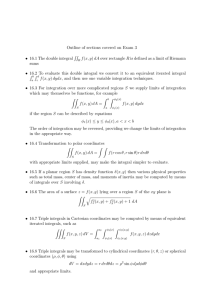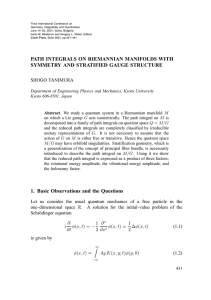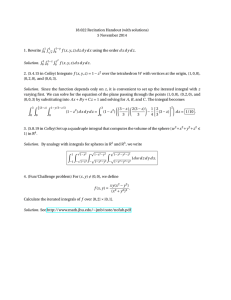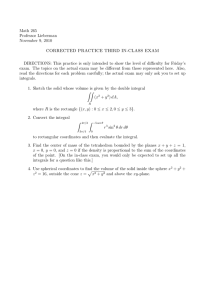( ) SM221 Spring 2007 Examination 3
advertisement
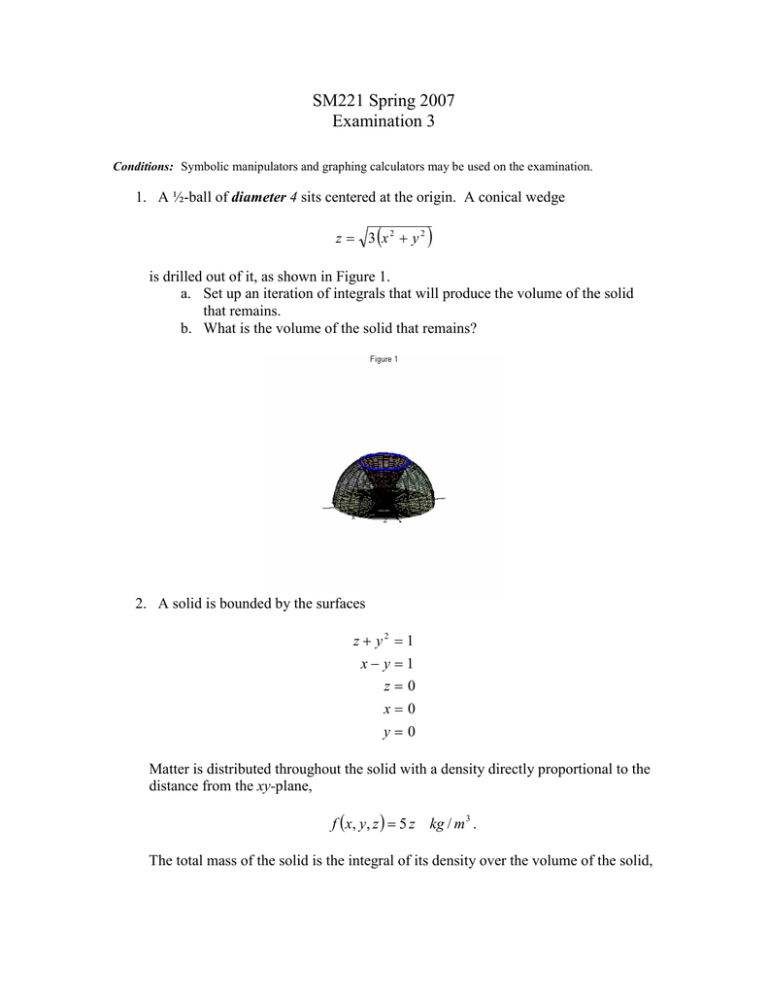
SM221 Spring 2007 Examination 3 Conditions: Symbolic manipulators and graphing calculators may be used on the examination. 1. A ½-ball of diameter 4 sits centered at the origin. A conical wedge ( z = 3 x2 + y2 ) is drilled out of it, as shown in Figure 1. a. Set up an iteration of integrals that will produce the volume of the solid that remains. b. What is the volume of the solid that remains? 2. A solid is bounded by the surfaces z + y2 = 1 x− y =1 z=0 x=0 y=0 Matter is distributed throughout the solid with a density directly proportional to the distance from the xy-plane, f ( x, y, z ) = 5 z kg / m 3 . The total mass of the solid is the integral of its density over the volume of the solid, M = ∫∫∫ f dV V a. Set up an iteration of integrals for the total mass of the solid. b. Compute the mass of the solid. 3. A four-bladed propeller is shown in cross section as Figure 2. Each blade is 1 meter long. In polar coordinates, the equation for the curve bounding the edge of the cross section is r = cos(2θ ) Assume the propeller has a uniform area mass density of 10 kg / m 2 . The total mass of the propeller is the integral of its density over the area of all four blades, M = ∫∫ 10 dA A a. Set up the multiple integral for the mass of the propeller. b. Evaluate the integral to compute the mass. 8 30 ∫ ∫ f ( x, y )dydx with the number of 4. a) Use the mid point rule to approximate x = 0 y =10 partitions m = 2 = n , if the following values are known for the function f ( x, y ) y/x 10 15 20 25 30 0 60 90 50 60 80 2 50 10 2 25 50 4 42 6 75 90 70 6 93 20 10 5 30 8 30 30 70 0 90 b) Reverse the order of integration for the following integrals (hint: a sketch of the region of integration helps) 2 x3 ∫ ∫ g ( x, y ) dydx x=0 y =0 1 y +1 ∫ ∫ h ( x, y ) dxdy y = 0 x = y 3 +1 5. Set up an iteration of integrals that produces the area of the surface x 2 + y 2 + z = 4 that is contained within the surface ( x − 1) + y 2 = 1 Do not evaluate the integral, just set it up. (Hint: draw the surfaces to see the extent.) 2 Left out. Problem #1 a. Set up an iteration of integrals that will produce the area of portion of the spherical surface that remains after the wedge is drilled. Do not evaluate the integral, just set it up. b. What is the area of the spherical surface that remains? 6. A surface is described by the parametric equation x(u , v ) = u + v y (u , v ) = u 2 + v 2 z (u , v ) = 2 u v and shown in Figure 3. Over the extent 0 ≤ u ≤ 1, 0 ≤ v ≤ 1 , set up an iteration of integrals for the surface area. Do not evaluate the iteration of integrals. 7. Set up the area integral of f ( x, y ) = 3xy over the region R bounded by the curves ( x − 1) + y 2 = 1 ( x − 1) − y 2 = 0 2 (x-1)^2 + y^2 =1 (x-1) - y^2 = 0 Do not evaluate the integral.

